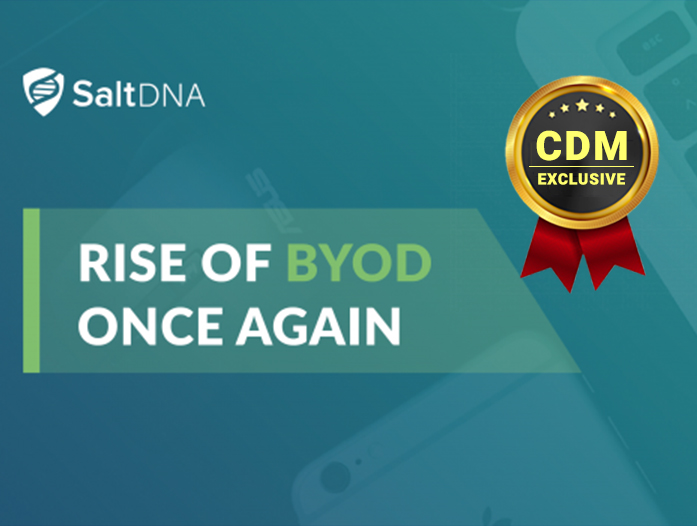By Nicole Allen, Marketing Executive, SaltDNA.
The sudden increase in remote working has ensured that ‘bring your own device’ (BYOD) is once again a hot topic, as the workforce relies on a number of devices, including personal phones and laptops, to get their jobs done from home or the workplace. This raises the question of how companies can not only gain insight into their holistic technology ecosystem but also how they can handle these proliferating devices.
Although remote working is not new, in the current situation it happens on a far greater scale. With BYOD on the decline in 2018 it yet again has risen and remote working has led to a massive spike in the approach to bring your own device (BYOD) with the BYOD market forecast to grow by 15.87% hitting $73.30 billion in 2021. In our recent webinar we discussed the increase in using personal devices throughout 2020 and the continued spike into 2021.
However, it is important to note that when more employees use their personal devices for work matters, organizations do have legal responsibilities to ensure that business, consumer, and confidential data remains secure. Although it had to be done with urgency to respond to COVID-19, this would not count as an exception for not adhering to security legislation. So it is important to deploy BYOD steps if you encourage workers to use personal devices for work. Even when COVID-19 is gone (whenever that will be), it is clear already that the increased concept of remote working is here to stay.
What is BYOD?
Bring your own device (BYOD) refers to the arrangement of workers using personal networks to interact and access work-related systems. These systems may potentially maintain sensitive or confidential data from within their organizational networks. Smartphones, personal computers, laptops, or USB drives all fit under the banner of being a ‘personal device’.
Many businesses are aware that BYOD’s benefits in the workplace far outweigh any potential risks. Potential security threats can be neutralised in most situations. There are many benefits of having a BYOD policy, increased productivity, employee satisfaction, and reduced company costs.
However, there are many risks associated with BYOD policies if you choose not to communicate securely…
Increased security risks
BYOD deployment means that the personal devices of a user have less power and visibility than you would want. Employees are not always cautious, and if they have too much access to data, employees can create disruption. Although you can educate heavily on best practices in defense, there is no assurance that when overwhelmed or busy, your workers will follow this advice or make questionable decisions.
Before COVID-19, new cybersecurity threats appeared every day, but cybercriminals have already manipulated the crisis to launch 667% more phishing attacks and are actively trying to take advantage of security vulnerabilities. It should also be noted that the weakest link in the security chain for organizations is the employees. By understanding threat strategies and documenting potential threats, workers need to be trained about how they can reduce security risks.
Another security threat is data leaks or breaches, data leakage is a greater possibility when personal devices come into play. When computers are misplaced or stolen, or if a privately owned computer is compromised by cybercriminals, data may be lost or exposed. Under GDPR, the preservation of confidential data remains a legal duty, regardless of whether it is stored on site or from the homes of your workers and their personal computers.
How to protect BYOD Devices
Over 15% of employees accessed sensitive data from non-work devices in 2020. Many businesses may be inclined to leap immediately to policy formation in order to respond to the increasing use of BYOD among businesses, but that approach is often met with friction. Until focusing on the development of new policies, the first move is to achieve both stakeholder and employee buy-in throughout the organization. Stakeholders will be crucial to the process of policy planning, offering a range of viewpoints across the company from different divisions and interests.
In addition, a policy for BYOD devices should be clearly defined, including what support is available for employees connecting to the company network, support for software downloaded on personal devices, and support for dispute resolution between personal apps and business apps.
Once the systems and protocols are in place, it is important to have ongoing employee education on the significance of appropriate use as well as basic data protection hygiene. In addition, the right security solution will reduce your BYOD risk and make it possible for your strategy to run smoothly. There are several components that an efficient BYOD protection solution should address. One that incorporates most or all of these elements and promotes a robust mobile security strategy is the perfect solution.
Luckily, all of these threats can be handled with the right technological and procedural controls. If you’ve determined that BYOD would work for you, you can consider identifying some elements and include them in an effective BYOD strategy.
Many organizations that SaltDNA continues to work with have looked at implementing device management platforms alongside our secure communications solution for a large number of their employees. For many large clients we deal with, however, their requirement for secure communications was the number one priority and they required a secure and scalable platform which they could provide to their senior employees to ensure complete privacy for the messages and calls they were carrying out. Being location independent, many of our clients have been able to remotely deploy our solution onto smartphones across the world, on many global networks within a matter of minutes.
The Rise of BYOD & The Future
While it is still uncertain how long organizations will keep functioning from home, COVID-19 has proven to be a success in regards to remotely operating. Due to it performing so well for organizations across the globe, remote work and BYOD are likely to continue beyond the COVID-19 pandemic.
For business success, mobile devices are crucial, and businesses must find ways to unlock the full value of their mobile strategies. In the short term, depending on workers to have their own mobile phones has cost advantages, but other expenses add up over time regardless of the device-distribution strategy, and supplying mobile phones to any or all employees offers value in various ways. Evaluate which employee groups will benefit most from the devices provided by the employer, and what resources and workflows are needed to promote communication with BYOD employees.
It’s no wonder, with this huge growth, that the BYOD market is expected to hit almost $367 billion by 2022, up from $30 billion in 2014. So a good investment is time spent ensuring that workers working from home are secure and safe, as up to 56% of employees are using their personal devices for remote work.
Our forecast? BYOD is here to stay. It is crucial that organizations implement tools that are able to fit into their BYOD and mobile strategies to remain secure in 2021 and beyond. The importance of location-independent services is growing, which also compliments the rise of BYOD policies.
If you would like to understand how SaltDNA can fit into your existing BYOD strategy and protect your confidential mobile communications, we can offer you a 30 day free trial to test our solution today by visiting our website HERE or emailing us at [email protected].
About SaltDNA
SaltDNA is a multi-award-winning cybersecurity company providing a fully enterprise-managed software solution giving absolute privacy in mobile communications. It is easy to deploy and uses multi-layered encryption techniques to meet the highest of security standards. SaltDNA offers ‘Peace of Mind’ for Organisations who value their privacy, by giving them complete control and secure communications, to protect their trusted relationships and stay safe. SaltDNA is headquartered in Belfast, N. Ireland, for more information visit SaltDNA.
About the Author
 Nicole Allen, Marketing Executive at SaltDNA. Nicole completed her university placement year with SaltDNA, as part of her degree studying Communication, Advertising, and Marketing at the University of Ulster. Nicole worked alongside her degree part-time during her final year and recently started full-time with the company having completed her placement year with SaltDNA in 2018/19.
Nicole Allen, Marketing Executive at SaltDNA. Nicole completed her university placement year with SaltDNA, as part of her degree studying Communication, Advertising, and Marketing at the University of Ulster. Nicole worked alongside her degree part-time during her final year and recently started full-time with the company having completed her placement year with SaltDNA in 2018/19.
Nicole can be reached online at (LINKEDIN, TWITTER or by emailing [email protected]) and at our company website https://saltdna.com/.

